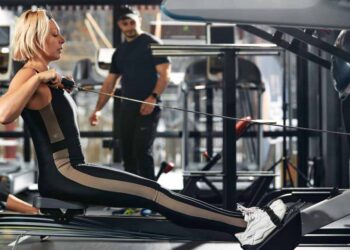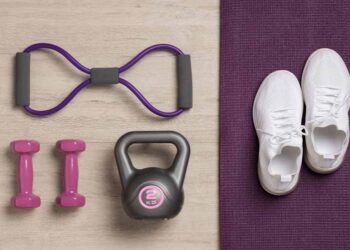In the quest for fitness and wellness, indoor rowing has surged in popularity, carving out a niche for itself among health enthusiasts of all ages. Known for its low impact yet high-efficiency workout, indoor rowing offers a unique blend of cardiovascular and strength training that appeals to both novices and seasoned athletes alike. This guide is your comprehensive introduction to indoor rowing, providing everything you need to get started on this rewarding journey. Whether your goal is to enhance your fitness routine, lose weight, or simply try something new, indoor rowing might just be the perfect fit for you.
01
of 04
The Appeal of Indoor Rowing
A Comprehensive Workout
Indoor rowing stands out for its ability to engage multiple muscle groups simultaneously, offering a full-body workout unlike any other. The rhythmic pull and release motion works your legs, core, back, and arms, providing a balanced exercise regime that strengthens and tones. Moreover, the cardiovascular benefits of indoor rowing are exceptional, promoting heart health and endurance.
Benefits of Indoor Rowing Workouts
One of the most compelling reasons to embrace indoor rowing is its remarkable efficiency in calorie burning and muscle engagement. A single session can burn anywhere from 400 to 700 calories, depending on the intensity and duration, making it an excellent choice for those looking to manage weight or improve fitness levels. Furthermore, indoor rowing is known for being kind on the joints, reducing the risk of injury associated with high-impact exercises.
02
of 04
Getting Started with Indoor Rowing
Equipment Overview
Choosing the right equipment is a crucial first step in embarking on your indoor rowing journey. While many opt for an indoor rowing machine, offering a range of features from air resistance to magnetic and water rowers, not everyone has the space, budget, or desire to purchase one immediately. For those interested in exploring the benefits of rowing without the machine, there are creative alternatives to mimic the rowing motion and engage the same muscle groups effectively.
Rowing Machines: For those looking to invest, consider models with adjustable resistance levels, comfortable seating, and user-friendly performance monitors to track your progress. The market offers a variety of options tailored to different needs and preferences, from the dynamic feel of a water rower to the quiet operation of a magnetic rowing machine.
Home Rowing Workouts Without a Machine: If you’re not ready to commit to a rowing machine, or simply lack the space, there are several innovative ways to engage in rowing workouts at home. Resistance bands, for example, can be used to simulate the rowing stroke by anchoring them to a low point and performing seated rows. This method helps target similar muscle groups, building strength and endurance with minimal equipment. Bodyweight exercises such as planks, squats, and burpees can also complement your rowing routine by enhancing core strength, stability, and cardiovascular health, essential components of effective rowing.
Setting Up Your Space
Your indoor rowing experience can be significantly enhanced by creating a dedicated and inviting workout area. Ensure sufficient space around your rowing machine for safety and ease of use. Consider adding elements like a motivational poster, adequate lighting, and a small fan for comfort. The right environment can greatly influence your motivation and consistency.
Basic Techniques and Safety
Mastering the correct rowing technique is crucial for maximizing the workout’s benefits and avoiding injury. Start with learning the basic rowing stroke, which includes the catch, drive, finish, and recovery phases. Pay attention to maintaining good posture and smooth, controlled movements. It’s often beneficial for beginners to consult online tutorials or seek guidance from a fitness professional to ensure proper form from the start.
03
of 04
Designing Your Indoor Rowing Routine
Creating a Balanced Workout Plan
A well-rounded cycling plan for weight loss incorporates variety to challenge the body and prevent workout plateaus. Start with setting a mix of short, high-intensity interval training (HIIT) sessions to boost metabolism and longer, steady-state sessions to build endurance. Aim for at least three to four sessions per week, gradually increasing the duration and intensity as your fitness improves.
Incorporating Indoor Rowing into Your Fitness Regime
Indoor rowing doesn’t have to stand alone. It complements other forms of exercise beautifully, such as strength training, yoga, or cycling, to create a holistic fitness program. For example, rowing on alternate days with strength training can ensure balanced muscle development and adequate recovery time.
Setting Goals and Tracking Progress
Setting clear, achievable goals is key to staying motivated and measuring the effectiveness of your indoor rowing routine. Whether it’s hitting a specific distance, calorie target, or consistency goal, tracking your progress will keep you motivated and informed about your development. Consider using a rowing app or journal to record your workouts and achievements.
04
of 04
Maximizing the Benefits of Indoor Rowing Workouts
Advanced Techniques and Challenges
Once comfortable with the basics, introducing advanced techniques or participating in rowing challenges can keep the workouts exciting and challenging. Techniques such as power strokes, sprint intervals, and pyramid training can significantly enhance your strength and endurance. Many online communities and apps offer monthly challenges that can help push your limits in a fun and competitive way.
Community and Support
Joining a community of fellow rowers can provide a wealth of support, motivation, and advice. Online forums, social media groups, and local clubs offer spaces to share experiences, celebrate milestones, and even participate in virtual races. Engaging with a community can also keep you accountable and more likely to stick with your routine.
Nutrition and Recovery
Nutrition plays a crucial role in fueling your workouts and achieving weight loss goals. A balanced diet rich in whole foods, lean proteins, and complex carbohydrates will support energy levels and recovery. Additionally, prioritizing post-workout recovery with adequate hydration, stretching, and rest days is essential for preventing injury and ensuring consistent progress.
Embarking on your indoor rowing journey can be one of the most rewarding decisions for your health and fitness. With the right approach, equipment, and mindset, you’re not just working towards weight loss; you’re investing in a lifestyle that promotes overall wellness, strength, and endurance. Remember, every stroke brings you closer to your goals. Start where you are, use what you have, and do what you can. The water is calm, and your boat awaits.














